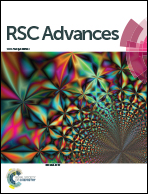Super-robust superamphiphobic surface with anti-icing property†
Abstract
Compared with superhydrophobic surfaces, superamphiphobic surfaces have a wider commercially availability. However, the initially fragile nature of micro or nano-structures hinders the large-scale applications of superamphiphobic surfaces. In this work, we report free-standing monoliths with durable superamphiphobic properties not only in the outer layer surfaces but also extending throughout the whole volume, which will demonstrate permanent superamphiphobicity. The monolith surface can repel a series of organic solutions with a surface tension as low as 36.4 mN m−1, and display good self-cleaning effect toward to blood or viscous mud. In addition, the monolith can maintain the superhydrophobicity no matter whether facing corrosive solution attack or mechanical abrasion, indicating the excellent chemical and mechanical properties. The monolith surfaces also display delayed-icing property and easy de-icing process.



 Please wait while we load your content...
Please wait while we load your content...